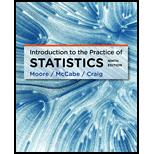
Concept explainers
(a)
Section 1:
To find: The difference in mean and standard error for body weight.
(a)
Section 1:
Answer to Problem 131E
Solution: The difference in mean for body weight is
Explanation of Solution
Calculation: The difference of mean can be calculated as follows:
The standard error (SE) of difference of mean can be calculated as follows:
Section 2:
To find: The difference in mean and standard error for calorie intake.
Section 2:
Answer to Problem 131E
Solution: The difference in mean for body weight is
Explanation of Solution
Calculation:
The difference of mean can be calculated as follows:
The standard error (SE) of difference of mean can be calculated as follows:
(b)
Section 1:
To test: The significant differences in body weight.
(b)
Section 1:
Answer to Problem 131E
Solution: There is no significant difference in body weight.
The t-statistic for the test hypothesis is obtained as t-value
The P-statistic for the test hypothesis is obtained as P-value
Explanation of Solution
Calculation: The hypothesis for study is defined as
To test the hypothesis that there is no significant difference in body weight, t-statistic is used to determine the significance of the difference. The t-value is obtained as follows:
Now, the P-value can be obtained by using the standard normal table for
Conclusion: The P-value for t-test is greater than
Section 2:
To test: The significant differences in calorie intake.
Section 2:
Answer to Problem 131E
Solution: There is no significant difference in calorie intake.
The t-statistic for the test hypothesis is obtained as t-value
The P-statistic for the test hypothesis is obtained as P-value
Explanation of Solution
Calculation: The hypothesis for study is defined as
To test the hypothesis, t-statistic is used to determine the significance of the difference. The t- value is obtained as follow:
Now, the P-value can be obtained by using the standard normal table for
Conclusion: The P-value for t-test is greater than
(c)
Section 1:
To find: The
(c)
Section 1:
Answer to Problem 131E
Solution: The required
Explanation of Solution
Calculation: The confidence interval for the difference of body weight can be obtained by first calculating the margin of error. The margin of error is obtained as follow:
Now, the confidence interval can be obtained as follows:
Interpretation: As the hypothesized mean of
Section 2:
To find: The
Section 2:
Answer to Problem 131E
Solution: The required
Explanation of Solution
Calculation: The confidence interval for the difference of calorie intake can be obtained by first calculating the margin of error. The margin of error is obtained as follow:
Now, the confidence interval can be obtained as follows:
Interpretation: As the hypothesized mean of
(d)
The summary of the results.
(d)
Answer to Problem 131E
Solution: The result cannot be generalized and the outcome of study will also have affected due to the violation of instruction by three subjects as the sample size is too small.
Explanation of Solution
Here, the study is biased for a specific city, the model cannot be generalized for a whole population, and there are three violations out of fourteen subjects. The effect could be a serious concern in the study due to small sample size.
Want to see more full solutions like this?
Chapter 7 Solutions
Introduction to the Practice of Statistics
 MATLAB: An Introduction with ApplicationsStatisticsISBN:9781119256830Author:Amos GilatPublisher:John Wiley & Sons Inc
MATLAB: An Introduction with ApplicationsStatisticsISBN:9781119256830Author:Amos GilatPublisher:John Wiley & Sons Inc Probability and Statistics for Engineering and th...StatisticsISBN:9781305251809Author:Jay L. DevorePublisher:Cengage Learning
Probability and Statistics for Engineering and th...StatisticsISBN:9781305251809Author:Jay L. DevorePublisher:Cengage Learning Statistics for The Behavioral Sciences (MindTap C...StatisticsISBN:9781305504912Author:Frederick J Gravetter, Larry B. WallnauPublisher:Cengage Learning
Statistics for The Behavioral Sciences (MindTap C...StatisticsISBN:9781305504912Author:Frederick J Gravetter, Larry B. WallnauPublisher:Cengage Learning Elementary Statistics: Picturing the World (7th E...StatisticsISBN:9780134683416Author:Ron Larson, Betsy FarberPublisher:PEARSON
Elementary Statistics: Picturing the World (7th E...StatisticsISBN:9780134683416Author:Ron Larson, Betsy FarberPublisher:PEARSON The Basic Practice of StatisticsStatisticsISBN:9781319042578Author:David S. Moore, William I. Notz, Michael A. FlignerPublisher:W. H. Freeman
The Basic Practice of StatisticsStatisticsISBN:9781319042578Author:David S. Moore, William I. Notz, Michael A. FlignerPublisher:W. H. Freeman Introduction to the Practice of StatisticsStatisticsISBN:9781319013387Author:David S. Moore, George P. McCabe, Bruce A. CraigPublisher:W. H. Freeman
Introduction to the Practice of StatisticsStatisticsISBN:9781319013387Author:David S. Moore, George P. McCabe, Bruce A. CraigPublisher:W. H. Freeman





